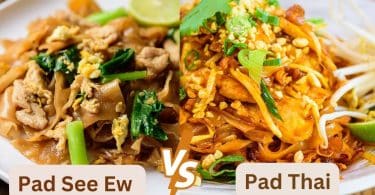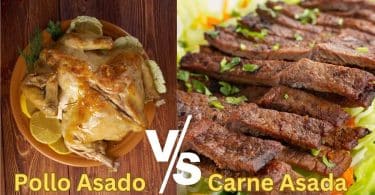Are you a lover of Indian cuisine or a curious food explorer looking to try something new? If so, you might have found yourself pondering over the difference between two of the most iconic Indian dishes: Chicken Tikka Masala and Butter Chicken. Both these dishes share a common lineage, yet they offer unique taste profiles that set them apart. This blog will delve into the nuances of these popular dishes, unraveling the mysteries of Chicken Tikka Masala vs Butter Chicken. We’ll explore their origins, ingredients, cooking processes, nutritional values, and much more, providing a comprehensive understanding of what distinguishes these dishes from each other.
Chicken Tikka Masala Vs Butter Chicken: Main Difference Between The Great Indian Food Face-Off
One of the primary differences between Chicken Tikka Masala and Butter Chicken lies in their core recipes and preparation methods. Chicken Tikka Masala, thought to be an Indian-inspired dish popularized in the United Kingdom, is traditionally made with boneless chicken pieces that are marinated in spices and yogurt, then baked in a tandoor oven before being added to a creamy tomato sauce. The sauce usually has a spicy kick, due to the addition of chili peppers or cayenne.
Butter Chicken, on the other hand, has its roots firmly planted in Delhi, India. This dish typically begins with tandoor-cooked chicken as well, but the curry sauce in which the chicken simmers is generally milder, creamier, and contains more butter, giving it a rich and velvety texture. The tomato flavor is less dominant in Butter Chicken, and the spice level tends to be more subdued, making it a favorite among those who prefer milder Indian dishes.
Ingredients: What Sets Chicken Tikka Masala Apart from Butter Chicken
The essence of any dish lies in its ingredients, and the same holds true when comparing Chicken Tikka Masala and Butter Chicken. Both dishes use chicken as the main ingredient, often marinated and cooked in a tandoor oven for a smoky flavor. However, the ingredients of their respective sauces differ slightly, providing distinct flavor profiles.
Chicken Tikka Masala’s sauce typically includes tomatoes, cream, and a variety of spices such as turmeric, cumin, and coriander. It often incorporates a higher amount of chili, which gives it a spicier taste. In contrast, Butter Chicken traditionally has a richer, creamier sauce, courtesy of generous quantities of butter and cream. It also includes tomatoes, but the butter and cream temper the tanginess of the tomatoes, resulting in a smoother, milder flavor.
Cooking Process: Comparing Chicken Tikka Masala and Butter Chicken
In terms of cooking methods, both dishes start with marinated, tandoor-cooked chicken. The chicken in Chicken Tikka Masala is often marinated longer, sometimes overnight, allowing the flavors to penetrate deeply into the meat. The tikka (or chicken pieces) are then char-grilled for a smoky flavor before being simmered in the spicy, creamy sauce.
Butter Chicken, on the other hand, typically involves simmering the tandoori chicken pieces in a butter-rich, tomato-based sauce. This process infuses the chicken with the sauce’s flavors while preserving its juiciness. It’s cooked until the chicken is tender and the flavors have melded together into a harmonious, delicious dish.
Nutritional Breakdown: Chicken Tikka Masala vs Butter Chicken
While both dishes are rich in proteins due to their chicken content, the difference lies in their caloric and fat content, largely because of the sauce ingredients. Chicken Tikka Masala, with its heavy use of tomatoes and cream, is slightly lighter than Butter Chicken. The latter, owing to its higher butter and cream content, usually contains more calories and fat.
However, the nutritional value can vary significantly based on the recipe and preparation methods. For instance, lighter versions of both dishes can be made by substituting full-fat cream with lower-fat alternatives or increasing the proportion of tomatoes in the sauce.
Popular Pairings: What to Serve with Chicken Tikka Masala and Butter Chicken
Both Chicken Tikka Masala and Butter Chicken are traditionally served with Indian breads like naan or rice varieties like basmati. They also pair well with side dishes like cucumber raita, a refreshing yogurt-based condiment, or a tangy Indian pickle.
The robust flavors of Chicken Tikka Masala pair well with a plain naan or rice, allowing the spicy, creamy sauce to shine. For Butter Chicken, the richness of the dish works well with jeera rice (cumin rice) or garlic naan, which add an extra layer of flavor without overpowering the main dish.
Which is Spicier? Chicken Tikka Masala or Butter Chicken
Generally, Chicken Tikka Masala is spicier than Butter Chicken. The former’s sauce often includes a higher quantity of spices, including chili, that give it a noticeable kick. Butter Chicken’s sauce, while still flavorful, is typically milder and creamier, with the butter and cream balancing out the heat of the spices.
Of course, the level of spiciness in both dishes can be adjusted to taste, and many restaurants will customize the spice level based on the diner’s preference.
Local Variations of Chicken Tikka Masala and Butter Chicken Around the Globe
Just as cuisines evolve with local tastes, so too have Chicken Tikka Masala and Butter Chicken. In the UK, where Chicken Tikka Masala is said to have been popularized, the dish often includes a mix of local and traditional Indian spices, with a sauce that is typically creamier and less spicy to cater to local palates.
Butter Chicken, on the other hand, has inspired variations such as the Canadian invention, Butter Chicken Poutine. In this fusion dish, the classic Butter Chicken sauce is used as a gravy over French fries and cheese curds, blending Indian flavors with a beloved Canadian dish.
In India, regional variations of both dishes abound, with some versions featuring local ingredients or adapted cooking methods. Regardless of where you are in the world, these two dishes continue to be loved and adapted, a testament to their universal appeal.
Why Chicken Tikka Masala is a Global Favourite?
Chicken Tikka Masala is an intriguing blend of tastes, mixing the bold, spicy flavors often associated with Indian cuisine with the familiar comfort of a creamy tomato sauce. This duality has helped it find favor with global audiences who appreciate the dish’s richness and depth of flavor. Additionally, Chicken Tikka Masala has been widely adopted in various countries, each adding their unique twist, making it a truly international dish. From being Britain’s national dish to a popular menu item in Indian restaurants across the globe, Chicken Tikka Masala’s robust flavor profile and versatility have earned it global acclaim.
How Butter Chicken Became an Indian Cuisine Staple?
Butter Chicken, or ‘Murgh Makhani’, originated in Delhi in the 1950s and quickly became a hit. It appealed to the masses with its mild but flavorful creamy tomato gravy, tandoor-cooked chicken, and an array of spices. Its popularity crossed borders, and it soon found its way onto Indian restaurant menus worldwide. The combination of its mild flavors, which appeals to those less accustomed to spicy food, and the richness of its sauce, which is a hit among those who love indulgent dishes, has cemented Butter Chicken’s status as a staple of Indian cuisine.
The Secret to a Perfect Chicken Tikka Masala Dish?
The secret to a perfect Chicken Tikka Masala dish lies in balancing its myriad flavors. The chicken should be marinated long enough to infuse it with the flavors of the spices and yogurt. The grilling or baking of the chicken should be done just right to achieve the smoky flavor characteristic of this dish. The sauce is equally important, with a careful balance of spicy and creamy elements. Tomatoes, cream, and a blend of spices, including turmeric, cumin, and chili, should harmonize without one overpowering the other. Lastly, a touch of lemon juice or a sprinkle of fresh cilantro just before serving can elevate the dish, adding freshness and zest.
Mastering the Art of Cooking Butter Chicken at Home
The key to mastering Butter Chicken at home lies in its preparation. Start by marinating the chicken in a mixture of yogurt and spices, allowing it to rest to absorb the flavors. The sauce requires careful attention to balance the creaminess of the butter and cream with the acidity of the tomatoes. A good blend of spices, including garam masala, cumin, and coriander, is essential to infuse the sauce with depth and complexity. Cooking the chicken separately before adding it to the sauce can help it stay moist and tender. Lastly, remember to adjust the seasoning just before serving, adding a splash of cream or a dollop of butter for extra richness, if desired.
Vegan Alternatives: Substituting Chicken in Tikka Masala and Butter Chicken
For those following a vegan diet, both Chicken Tikka Masala and Butter Chicken can be easily modified. Tofu, tempeh, or seitan can be excellent substitutes for chicken. Marinate them just as you would with chicken, and bake or grill for the best flavor. Dairy products can be replaced with plant-based alternatives: coconut milk or cashew cream works well in place of dairy cream, and vegan butter or coconut oil can replace regular butter. With these substitutions, you can enjoy the flavors of these beloved dishes while sticking to a plant-based diet.
Choosing the Right Ingredients for Your Chicken Tikka Masala or Butter Chicken
Choosing high-quality, fresh ingredients can significantly impact the end result of your Chicken Tikka Masala or Butter Chicken. Opt for fresh chicken, ideally free-range or organic, for the best flavor and texture. Fresh spices will provide more potent flavors than older, stale ones. Use ripe, juicy tomatoes for the sauce, as they will provide a good balance of sweetness and acidity. If using cream, choose a full-fat version for a richer, creamier sauce. However, if you’re conscious about the dish’s richness, low-fat alternatives can work too. By carefully choosing your ingredients, you can ensure that your dish is flavorful, aromatic, and authentic.
Conclusion
whether you are a fan of the spicy and tangy Chicken Tikka Masala or the rich and creamy Butter Chicken, the allure of these Indian dishes lies in their complex flavors, versatility, and the warmth they bring to the table. Their global popularity signifies not only the universal appeal of Indian flavors but also the ability of food to transcend boundaries and bring people together.
Mastering these dishes at home can be an enriching culinary adventure, and with the tips and insights provided in this blog, you’re well-equipped to embark on that journey. Remember, the heart of these dishes lies in the careful balance of ingredients and spices. Don’t shy away from experimenting with flavors and adjusting the recipes to suit your palate.
And finally, food is all about inclusivity. The ease with which these dishes can be adapted to various dietary needs, like vegan or low-fat diets, ensures everyone can enjoy them. So whether you’re cooking these dishes at home or enjoying them at your favorite restaurant, remember to savor every bite and enjoy the symphony of flavors that is Indian cuisine. Happy eating!





Leave a Comment